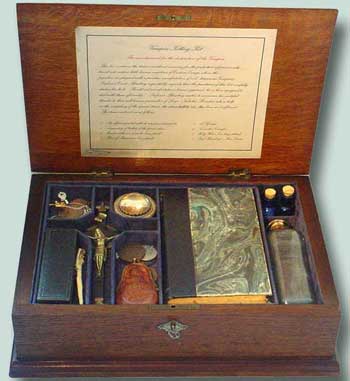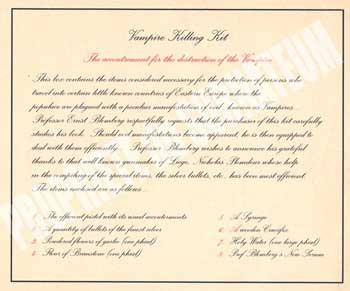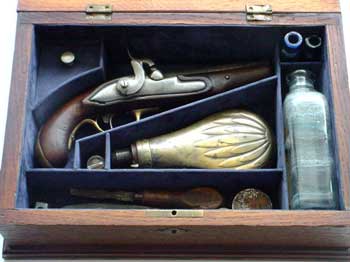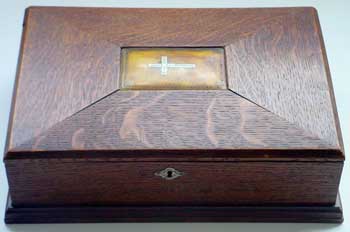|
|
 Inv.SCT/SV/pt-90151 Inv.SCT/SV/pt-90151
The executioner
Rhesus 3
Vampire Killing Kit, second half of the 19th century
The pistol dates from the 18th century and was brought back from the
expedition.
Brought back from an expedition to Russia and Mongolia in September
2001

Description
The Vampire Killing Kit was sold by Professor Ernst Blomberg in the
second half of the 19th century. The kit was made by Nicolas Plomdeur, a
well-known gunmaker from Liège.
This particular box, which has been in the Surnateum's collection
since the late 19th century, has recently been reunited with the
accompanying pistol (made in Spain in the late 18th century, originally a flintlock but
later converted to a percussion cap in the first half of the 19th
century); the gun was lost under circumstances described below.
Manufactured in two separate stages, it contains all of the
accessories used to maintain the pistol, as well as a large bottle of
holy water, small bottles which once contained Professor Blomberg's
anti-vampire serum and garlic juice to impregnate the silver bullets, a
small bottle of sulphur powder, whose odour could drive off vampires. A crucifix
made of wood and copper, various blessed medals, a small bottle of
salts, a copy of the 1819 book entitled Histoire
des Fantômes et des Démons by Gabrielle de P. (see
the Library).
A user's guide (in English) glued to the inside cover of the kit reads
as follows:
Vampire Killing Kit
|
The accoutrement for the destruction of the Vampire
This box contains the items considered necessary for the protection
of persons who travel into certain little known countries of Eastern
Europe where the populace are plagued with a peculiar manifestation
of evil, known as Vampires...
Professor Ernst Blomberg respectfully requests that the purchaser
of this kit carefully studies his book. Should evil manifestations
become apparent, he is then equipped to deal with them efficiently...
Professor Blomberg wishes to announce his grateful thanks to that
well known gunmaker of Liege, Nicholas Plomdeur, whose help in
the compiling of the special items, the silver bullets, etc.,
has been most efficient.
The items enclosed are as follows...
|
1. The efficient pistol with its usual accouterments
|
5. A Syringe
|
|
2. A quantity of bullets of the finest silver
|
6. A wooden Crucifix
|
|
3. Powdered flowers of garlic (one phial)
|
7. Holy Water
|
|
4. Flour of Brimstone
|
8. Prof Blomberg's New Serum
|
|

Although extremely rare, these Vampire Killing Kits are sometimes
found in private collections. Our friends in the group Fear
No Evil have two, one in German and one in English.
The Ripley's Believe It or Not museums also have one.

Explanation by the Curator
When I arrived at the Surnateum's Secret Department,
the entire team was already there.
I greeted the librarian, the Curator's wife and Miss Fay with a
friendly gesture, then a familiar voice addressed me.
"Did you have a problem with the access codes?"
the Curator asked me, his lips curling in a sardonic smile.
"I couldn't find the key in the Glossary!" I replied,
a bit out of breath.
"But I suppose your talent for predicting the future meant
that you predicted I would be late tonight... "
I glanced around; it smelled like wet paint. I rarely visited this
department, but I was certainly not immune to the contents of the hidden
part of the museum. It explains the true nature of the Institute and of sensitives, but it is only accessible to a tiny elite capable of
perceiving the other side of reality and passing the testes allowing
access to this place.
That was when the Curator started speaking.
"Merry Christmas and Happy Holidays to everyone!
This has been a year of discovery for the Museum. As you can see,
the Secret Department has been entirely overhauled and new acquisitions
have recently been released from the Quarantine Section to join the
collections. They will soon be on display. The Department of Haunted
Antiques has found a full Ghost Hunter's Kit dating from the period
between the wars; the Library has acquired the rare 1714 edition of the
Dictionnaire des Drogues Simples, along with a number of sought-after grimoires. I would especially like to congratulate our expedition
leader, whose trip to Mongolia and Russia yielded the treasures you see
here. This full shaman's kit was purchased at a market in Ulaanbaatar,
and an analysis of its contents may allow us to find traces of the
existence of the allghoi khorkhoi, the mythical Mongolian death
worm. I saw the director of the Department of Cryptozoology rub his
hands. The khanne will be carefully studied before joining the
other Hauntiques; but something that I am especially pleased with, and
something that was one of the main reasons behind the expedition to
Mongolia, was the return of the missing piece of the 'Rhesus' puzzle."
Opening a chamois leather pouch, the Curator removed an ancient pistol
measuring about
25 cm in length and clearly of an impressive calibre. Probably a .50, a very rare,
perhaps even unique, model.
"I would like to thank Christian Bréard at the Department
of Fine Restoration Work for his excellent work on this firearm and
for returning it to perfect working order.
But let me tell you about the background of this extraordinary item
and then you will understand why the Collector and I are so pleased."
"In publishing the Traité sur les apparitions
des Esprits, et sur les vampires ou les revenans de Hongrie, de Moravie,
&c. by Dom Augustin Calmet in 1746, the Church officially
acknowledged the existence of vampires and other creatures of the night.
Yes, yes, I know - only the 1751 edition of the book is considered to be
authoritative. But that doesn't matter! The book was published in the wake
of and in response to the great vampire scare in the first half of the
18th century, prompted in part by the cases of Arnold Paole and Peter Plogojowitz.
However, it was not until 1789 that the Church decided to arm a small
team of monster-hunters to fight these creatures. The team comprised a
French priest specialising in exorcism and invocation and - assuming I'm
not confusing nationalities - a German tracker and a Spanish
executioner. A firearm was designed and ritualised by three bishops so
that the Spaniard could carry out his work efficiently. On the stock of
the barrel were encrusted three silver crucifixes representing Golgotha
and the weapon was consecrated during an extremely rare planetary
conjunction (which must include a syzygy, an alignment of the sun, moon
and earth). The pistol was originally a flintlock, but was later
converted to a percussion cap system around 1820. The silver bullets
were soaked in a mixture of garlic juice and holy water,
and were in any case large enough to ensure that there was little
chance of failure - especially if the target was hit in the head.
Ideally, a wooden rosary was to be worn by the killer in order to weaken
his prey. The executioner prepared the weapon for rapid use by lightly
filing the lower part of the ramrod so that it would not get stuck in
his clothes, thus allowing him to draw quickly in case of a surprise
attack.
The gun has occasionally come in handy over the last few centuries - and
not just for vampires and werewolves.
Having fallen into disuse in the second half of the 19th century, the
weapon was acquired by the first Collector in 1877.
It was around that time that he had a certain Professor Blomberg put
together the case.
It is said that he first used the pistol in 1888 against a creature
dubbed
Jack the Ripper by the British press of the day. The
Ripper was a
bloodthirsty entity whose remains have been lying at the bottom of the
Thames for more than a century.
The Collector has always been very reserved on this topic, but I
believe that it was an officer in the Indian Army who had been infected
by local magic and whose transformation was amplified during a Golden Dawn
ritual. The Golden Dawn was an esoteric sect founded early that year.
The case was covered up because it implicated a number of very
high-level figures in London.
Nevertheless, the pistol was still housed at the Surnateum when, in 1943,
an emissary from the Archbishop of Ghent found the Collector and told
him a very strange story indeed. The priest had heard, during a
confession, the story of an old dying bishop by the name of Eugenius van Rechem.
The very same one linked to the 'Schlemihl' affair. He had not
understood everything because the dying man spoke with such a feeble
voice and was unable to finish his story, but had demanded help. He had
talked of inaccessible sacred relics (without giving further
information), a doctor, experiments with blood, vampires and Adolf Hitler.
The Collector, who was aware of the magical and apocalyptic experiments
carried out by the Thule Gesellschaft at the end of the First World War,
had taken the story very seriously indeed.
He also remembered that another sensitive, F.W.
Murnau, had made a prophetic film announcing the coming of the vampire.
He understood why all of the attempts at eliminating the monster had
automatically failed, each time multiplying Hitler's demented rage
tenfold.
With each failed attempt, the Führer's protection grew stronger.
It became necessary to train an executioner and to place him close to
Hitler. There was no question of creating a new weapon, since the
conditions in which the consecration ritual were possible only materialised once every 430 years. The pistol was therefore removed from
its hiding place, carefully cleaned and prepared, and new silver bullets
were cast and treated. The pistol was then secretly brought to Berlin,
where it was handed over to the killer. The executioner had to be a
German and someone close enough to Hitler to be able to approach him and
eliminate him. After looking at several options, the Collector opted for
a young major, an SS Sturmbannführer in the Waffen SS by the name
of Otto G., with whom a meeting was organised. Also present at the
meeting were a senior official from the Ahnenerbe, still secretly linked
to the Thule Gesellschaft, and a high officer from the Waffen SS with a
predatory face. At first appalled by the proposition put to him, the major hurled abuse at
the 'traitors' and 'conspirators', threatening to report them
immediately. He then calmed down and ended up letting himself be
persuaded by the arguments presented to him. The light of doubt began to
make its way through his unquestioning certainty. The Collector
persuaded him to observe Hitler closely and to find clear evidence of
the reality of the situation, in which case his SS honour would oblige
him to take action - for the good of Germany and for the good of humanity.
The dignitary from the Thule Gesellschaft then spoke to him at length
about an ancient bottle, a ritual activated in 1919 by people who were
unaware of what they were doing and its consequences, including the six
million deaths that the war had already caused. He was promised that no
matter what happened to him, his young child would be protected from the
vengeance of the Nazis and from the Russians who would invade Berlin
before the American and British Allies arrived. And if he were captured
by the Allies then everything would be done to have him released or to
have his sentence minimised.
The right moment presented itself during the afternoon of Monday, 30 April 1945.
Shortly after marrying Eva Braun, a depressed Hitler announced that he
was going to commit suicide; the excuse was perfect.
Otto joined Hitler and his wife in the apartment's anteroom.
Eva had just taken poison and the Führer was staggering about. The cyanide
he had just taken was not having an effect on him; nothing could kill
him. At that moment, understanding that everything he had been told was
true, the Waffen SS officer drew the pistol, stuck the barrel in
Hitler's mouth and fired the silver bullet at point-blank range.
He then ordered the body to be burned. He threw a different pistol (an
automatic model missing a round) onto the floor to make it look like
suicide. The monster's body then had to be incinerated. This was a
dangerous task given the Russian bombardment, but it was a task that had to be done and
required nearly 200 litres of petrol. Unfortunately, in the
confusion following the flight from the bunker and the major's arrest by
the Russians, the Surnateum's pistol was lost. It was later found and kept as
a 'souvenir' by a Russian soldier, who probably ended up trading it for cigarettes
and vodka.
No connection was ever made between the pistol and Hitler's burned body.
We only had a vague name, nothing more, of a Russian soldier who was
involved in the interrogation of Otto G. The German major served just
part of his sentence and was reunited with his child after leaving prison
some 10
years later. The Collector always keeps his word.
It took just 46 years of searching and delicate contacts with people in
Moscow to find the pistol and bring it back.
Of course, this is not the only 'magic' weapon in the Museum's
possession, but we always very much regretted losing it. It was returned to its
case in the Vampire Section of the Department of Cryptozoology.
I raise my glass of absinth and offer a toast to the health of the
Surnateum's exploration and restoration teams.
To your good health and a Happy New Year to you all!"

The clothes worn by Adolf Hitler during the attack on
20 June 1944 were incinerated in secret on 27 August 1947 by an Allied
team, with the blessing of Winston Churchill.
The Collector was on hand to ensure that every last drop of Hitler's
blood was obliterated from the face of the earth.
The 'unofficial' reason given was that the authorities wanted to make
sure that his clothing did not achieve 'relic' status.
An original copy of this extraordinary document (photographed by International
News
Photos) can be found in the secret archives of the Surnateum.
This exceedingly rare document discreetly confirms and concludes the
series of events code-named 'Rhesus'.

Return to top of page
|

